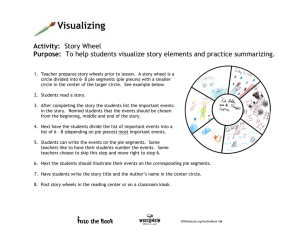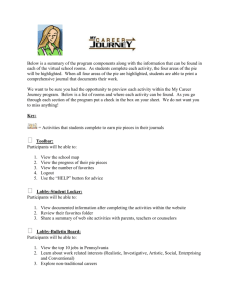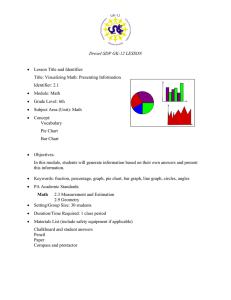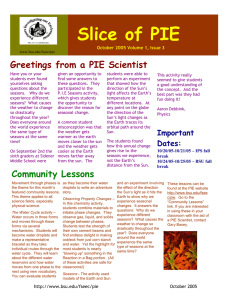Slice of PIE Greetings from a PIE Scientist
advertisement
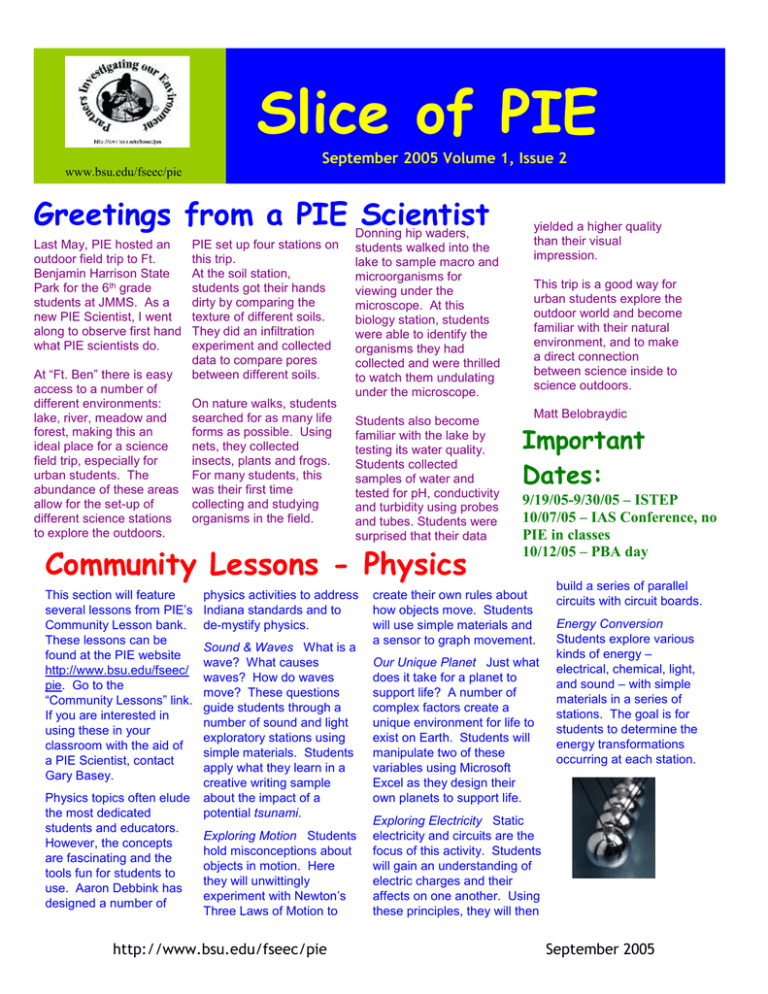
Slice of PIE September 2005 Volume 1, Issue 2 www.bsu.edu/fseec/pie Greetings from a PIE Donning Scientist hip waders, Last May, PIE hosted an outdoor field trip to Ft. Benjamin Harrison State Park for the 6th grade students at JMMS. As a new PIE Scientist, I went along to observe first hand what PIE scientists do. At “Ft. Ben” there is easy access to a number of different environments: lake, river, meadow and forest, making this an ideal place for a science field trip, especially for urban students. The abundance of these areas allow for the set-up of different science stations to explore the outdoors. PIE set up four stations on this trip. At the soil station, students got their hands dirty by comparing the texture of different soils. They did an infiltration experiment and collected data to compare pores between different soils. On nature walks, students searched for as many life forms as possible. Using nets, they collected insects, plants and frogs. For many students, this was their first time collecting and studying organisms in the field. students walked into the lake to sample macro and microorganisms for viewing under the microscope. At this biology station, students were able to identify the organisms they had collected and were thrilled to watch them undulating under the microscope. Students also become familiar with the lake by testing its water quality. Students collected samples of water and tested for pH, conductivity and turbidity using probes and tubes. Students were surprised that their data Community Lessons - Physics This section will feature several lessons from PIE’s Community Lesson bank. These lessons can be found at the PIE website http://www.bsu.edu/fseec/ pie. Go to the “Community Lessons” link. If you are interested in using these in your classroom with the aid of a PIE Scientist, contact Gary Basey. Physics topics often elude the most dedicated students and educators. However, the concepts are fascinating and the tools fun for students to use. Aaron Debbink has designed a number of physics activities to address Indiana standards and to de-mystify physics. Sound & Waves What is a wave? What causes waves? How do waves move? These questions guide students through a number of sound and light exploratory stations using simple materials. Students apply what they learn in a creative writing sample about the impact of a potential tsunami. Exploring Motion Students hold misconceptions about objects in motion. Here they will unwittingly experiment with Newton’s Three Laws of Motion to http://www.bsu.edu/fseec/pie yielded a higher quality than their visual impression. This trip is a good way for urban students explore the outdoor world and become familiar with their natural environment, and to make a direct connection between science inside to science outdoors. Matt Belobraydic Important Dates: 9/19/05-9/30/05 – ISTEP 10/07/05 – IAS Conference, no PIE in classes 10/12/05 – PBA day create their own rules about how objects move. Students will use simple materials and a sensor to graph movement. Our Unique Planet Just what does it take for a planet to support life? A number of complex factors create a unique environment for life to exist on Earth. Students will manipulate two of these variables using Microsoft Excel as they design their own planets to support life. build a series of parallel circuits with circuit boards. Energy Conversion Students explore various kinds of energy – electrical, chemical, light, and sound – with simple materials in a series of stations. The goal is for students to determine the energy transformations occurring at each station. Exploring Electricity Static electricity and circuits are the focus of this activity. Students will gain an understanding of electric charges and their affects on one another. Using these principles, they will then September 2005 PIE = Partners Investigating the Environment…a partnership between scientists and educators. Science Puzzle Q: What is a shooting star? A: A shooting star is a meteoroid – a fragment of an asteroid or comet, made of iron, silicates of a mixture of both. When the asteroid or comet is shattered by an explosion in space, meteoroids are propelled through the earth’s atmosphere, creating friction, which heats up the shooting star and gives it the glow we see. www.bayerus.com/msms/fun/riddles/ Current Events “One thing I have learned in a long life: that all our science, measured against reality, is primitive and childlike – and yet it is the most precious thing we have.” Albert Einstein be complex and difficult for how the complexity of students (and adults) to physics creates comfort comprehend, simple and convenience at: experiments allow your http://physics.org students to explore Do you or your students physical principles and wonder if and how boards theories. See the PIE and blocks can really be Community Lessons for September is National Physics broken with bare hands? some classroom ideas. Month and 2005 has been Find out the facts at: declared the Year of Physics If you don’t find what you www.kungfuscience.org in honor of one of Einstein’s are looking for there try a Stage a class debate about most contributive years as a few other places: nuclear power. (This is a scientist. Would like to bring Send your students on a great segue into October, more physics to your WebQuest to discover the Energy Awareness Month.) classroom to celebrate? everyday influence of How did scientists While the laws of physics may physics in our lives. See determine the Websites circumference of the planet before measuring tapes and GPS units? By the sun and some poles, of course. Participate in a revival of the Eratosthenes experiment by measuring the earth’s circumference with other students around the world. See: http://physics2005.org or www.globe.gov for more information. Journaling th http://in6.msscience.com - This links to the IPS 6 grade textbook. It is chocked full of activities and resources. http://www.physics.org - Common physics questions answered for teachers and students. **Teachers: do you have websites that you would like to share with other teachers? E-mail me sshines@bsu.edu. Coming in October: Chemistry and Energy Awareness Months. For information or questions, contact: Dr. Gary Basey gbasey@bsu.edu 765-285-8833 http://www.bsu.edu/fseec/pie Many teachers find journaling an effective way of monitoring their students’ progress and assessing student knowledge before beginning a new concept. Here are some writing prompts that can accomplish these two things. To pre-assess Have you heard of (new concept) before? Describe what you think it means and/or what it involves. What do you think of when you read the word (words relating to new concept or new concept)? To evaluate progress: What did you do in science this week? What did you learn in science this week? What were some of the materials/equipment you used in science today/this week and why did you use them? How does (new concept) connect to (old concept)? September 2005


